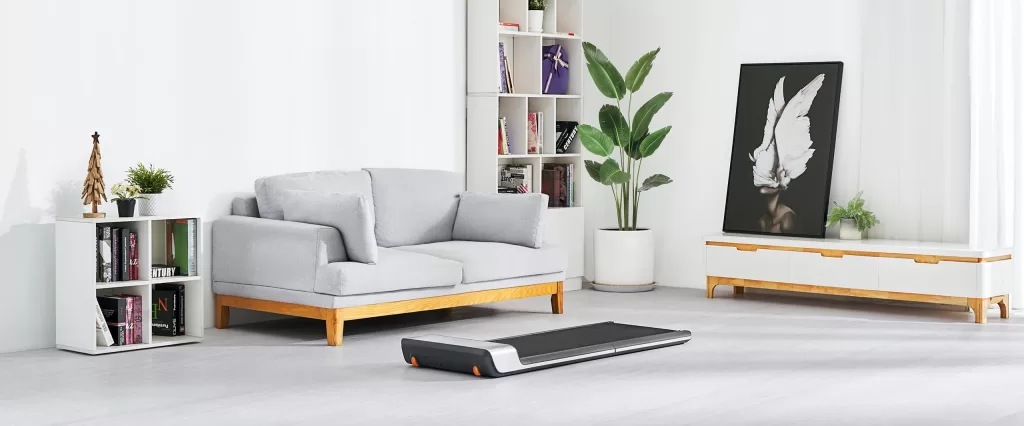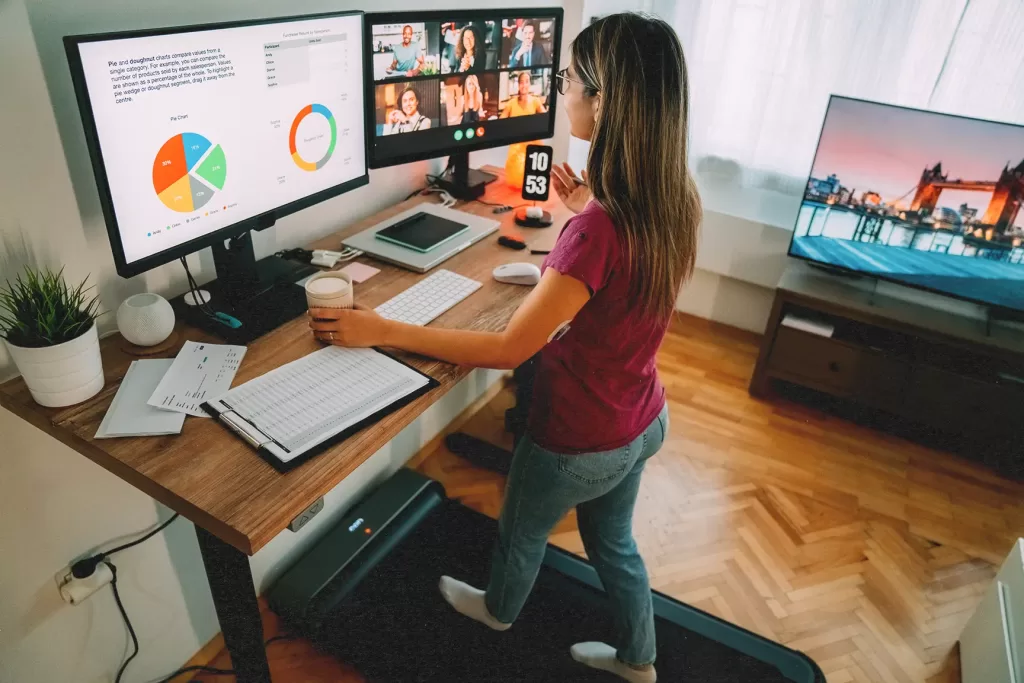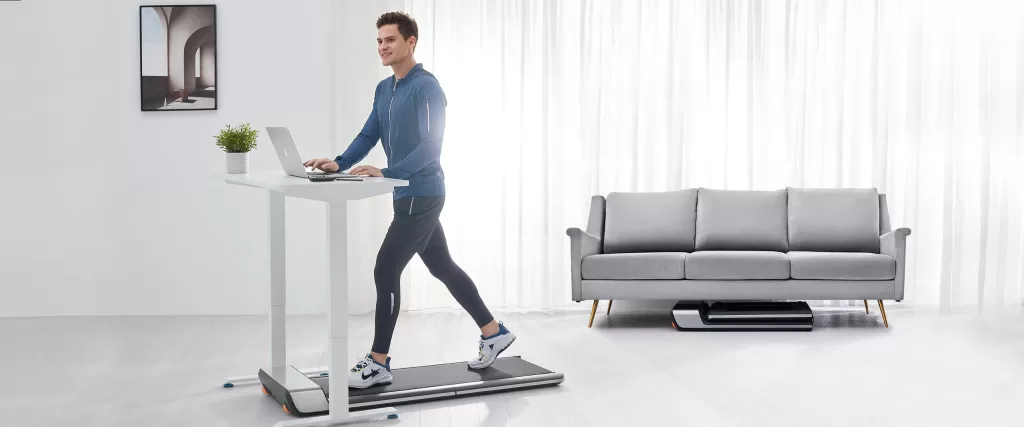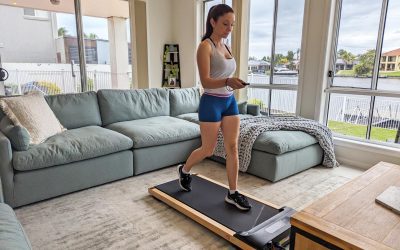
Walking desks, also known as treadmill desks or walking workstations, are a type of desk that allows individuals to walk while they work. These desks typically consist of a treadmill base with an adjustable desk positioned over the top, allowing users to walk at a slow pace while performing their daily tasks. The concept of walking desks is based on the idea that sitting for long periods of time can have detrimental effects on health, and that incorporating movement into the workday can have numerous benefits.
Walking desks work by combining the benefits of physical activity with the necessity of work. Users can set the treadmill to a desired speed, usually ranging from 1 to 4 kilometres per hour, and walk while they complete their tasks. The desk is designed to be ergonomic, with enough space for a computer, keyboard, and other necessary items. Some walking desks also come with additional features such as height adjustability and built-in fitness trackers.
The idea of walking desks is not new, but it has gained popularity in recent years as more research has emerged about the negative effects of sitting for long periods of time. The concept can be traced back to the 1990s when Dr. James Levine, a researcher at the Mayo Clinic, began studying the effects of sedentary behaviour on health. Since then, walking desks have become more accessible and affordable, making them a viable option for individuals looking to incorporate more movement into their workday.
Key Takeaways
- Walking desks are desks that allow you to walk while you work, combining physical activity with office work.
- Using a walking desk can improve your health, increase productivity, and reduce the negative effects of sitting for long periods.
- When choosing a walking desk, consider factors such as size, adjustability, and noise level.
- Setting up your walking desk properly is important for comfort and effectiveness, including adjusting the height and positioning of your computer.
- To maximize the benefits of your walking desk, incorporate walking breaks into your workday and use strategies to stay focused and productive while on the move.
The Benefits of Using a Walking Desk: From Improved Health to Increased Productivity

One of the main benefits of using a walking desk is improved cardiovascular health. Walking is a low-impact form of exercise that gets the heart pumping and increases blood flow throughout the body. Regular physical activity has been shown to reduce the risk of heart disease, stroke, and other chronic conditions. By incorporating walking into their workday, individuals can improve their cardiovascular health and reduce their risk of developing these diseases.
In addition to improved cardiovascular health, using a walking desk can also reduce the risk of other chronic diseases. Studies have shown that sitting for long periods of time is associated with an increased risk of obesity, type 2 diabetes, and certain types of cancer. By incorporating movement into their workday, individuals can help prevent these diseases and maintain a healthier weight.
Another benefit of using a walking desk is increased productivity and focus. Walking has been shown to increase blood flow to the brain, which can improve cognitive function and enhance creativity. Many users report feeling more alert and focused while using a walking desk, which can lead to increased productivity and efficiency in the workplace.
Using a walking desk can also have positive effects on mood and mental health. Exercise has been shown to release endorphins, which are chemicals in the brain that help improve mood and reduce stress. Walking has also been shown to reduce symptoms of anxiety and depression. By incorporating movement into their workday, individuals can experience these mental health benefits and improve their overall well-being.
Choosing the Right Walking Desk: Factors to Consider Before Making a Purchase
Before purchasing a walking desk, there are several factors to consider to ensure that you choose the right one for your needs.
Firstly, budget is an important consideration. Walking desks can range in price from a few hundred dollars to several thousand dollars. It’s important to determine how much you are willing to spend before beginning your search.
Space availability is another factor to consider. Walking desks come in various sizes, so it’s important to measure the space where you plan to set up your desk to ensure that it will fit comfortably.
Desk size and adjustability are also important considerations. Some walking desks come with adjustable height options, allowing users to find the most comfortable position for their work. It’s important to choose a desk that is large enough to accommodate your computer, keyboard, and other necessary items.
Treadmill speed and noise level are also factors to consider. Some walking desks have a limited range of treadmill speeds, so it’s important to choose one that matches your desired pace. Additionally, consider the noise level of the treadmill, as some models can be quite loud and may be disruptive in a quiet work environment.
Setting Up Your Walking Desk: Tips and Tricks for a Comfortable and Effective Setup
| Metrics | Description |
|---|---|
| Desk Height | The height of the desk should be adjusted to the user’s elbow height when standing with their arms at a 90-degree angle. |
| Treadmill Speed | The speed of the treadmill should be set to a comfortable walking pace, typically between 1-2 mph. |
| Footwear | Wearing comfortable and supportive shoes is important to prevent foot and leg fatigue. |
| Posture | Proper posture is important to prevent strain on the neck, shoulders, and back. Keep shoulders relaxed and back straight. |
| Breaks | Take frequent breaks to stretch and move around to prevent stiffness and fatigue. |
| Hydration | Drinking plenty of water is important to stay hydrated and prevent fatigue. |
Once you have chosen the right walking desk for your needs, it’s important to set it up properly to ensure a comfortable and effective workspace.
Proper footwear is essential when using a walking desk. Choose shoes that provide good support and cushioning to prevent foot and leg fatigue. Avoid wearing high heels or shoes with minimal support, as these can lead to discomfort and potential injury.
Desk height and posture are also important considerations. Adjust the height of your desk so that your arms are at a comfortable 90-degree angle when typing or using the mouse. Maintain good posture while walking, keeping your back straight and shoulders relaxed.
Desk accessories can also enhance your walking desk setup. Consider adding a monitor stand or laptop riser to bring your screen to eye level, reducing strain on your neck and shoulders. Use an ergonomic keyboard and mouse to prevent wrist and hand discomfort.
Lighting and ventilation are often overlooked but important aspects of a comfortable workspace. Ensure that your walking desk is well-lit to reduce eye strain and fatigue. If possible, position your desk near a window or use a fan or air purifier to improve air circulation.
Getting Started with Your Walking Desk: How to Incorporate Walking into Your Workday
Once your walking desk is set up, it’s important to start incorporating walking into your workday gradually to avoid overexertion or discomfort.
Begin by setting a goal for how much time you want to spend walking each day. Start with a conservative goal, such as 30 minutes, and gradually increase the amount of time you spend walking each day.
Scheduling walking breaks throughout the day can help you incorporate more movement into your workday. Set reminders on your phone or computer to take short breaks every hour or so to get up and walk around.
Multitasking while walking can also help you make the most of your time on the treadmill. Use a hands-free headset to make phone calls or listen to podcasts or audiobooks while walking. You can also use a tablet or e-reader to read documents or articles while walking.
Combining Walking and Work: Strategies for Staying Focused and Productive While on the Move

Combining walking and work can be challenging, but with the right strategies, it is possible to stay focused and productive while on the move.
One strategy is to prioritize tasks based on their level of difficulty or importance. Save more complex tasks for when you are sitting at your desk and use your walking time for simpler, less demanding tasks.
Using a timer can also help you stay focused and productive. Set a timer for a specific amount of time, such as 25 minutes, and work on a task until the timer goes off. Take a short break to walk or stretch, then set the timer again and continue working.
Breaking up tasks into smaller chunks can also help you stay focused and productive while using a walking desk. Instead of trying to complete a large task all at once, break it down into smaller, more manageable tasks. This can help prevent overwhelm and make it easier to stay focused.
Maximizing the Health Benefits of Your Walking Desk: How to Boost Your Cardiovascular Health, Burn Calories, and More
While simply walking on a treadmill desk can provide numerous health benefits, there are ways to maximize these benefits and get the most out of your walking desk experience.
Varying treadmill speed and incline can help boost cardiovascular health and burn more calories. Start with a comfortable walking pace and gradually increase the speed over time. You can also adjust the incline to add more intensity to your workout.
Incorporating strength training exercises into your walking desk routine can help build muscle and increase calorie burn. Use resistance bands or small weights to perform exercises such as bicep curls, shoulder presses, or squats while walking.
Tracking your progress with fitness apps or wearable devices can help you stay motivated and monitor your progress. Many walking desks come with built-in fitness trackers, but you can also use a smartphone app or wearable device to track your steps, distance, and calories burned.
Overcoming Common Challenges: Dealing with Fatigue, Discomfort, and Other Issues While Using a Walking Desk
Using a walking desk can come with its own set of challenges, but there are strategies to overcome these challenges and make your experience more comfortable and enjoyable.
Proper hydration and nutrition are essential when using a walking desk. Drink plenty of water throughout the day to stay hydrated and replenish fluids lost through sweating. Eat balanced meals and snacks that provide sustained energy to prevent fatigue.
Stretching and taking regular rest breaks can help prevent discomfort and fatigue while using a walking desk. Take short breaks every hour or so to stretch your legs, back, and shoulders. Incorporate stretching exercises into your routine to improve flexibility and prevent muscle imbalances.
Adjusting treadmill speed and incline can also help alleviate discomfort. If you are feeling fatigued or experiencing discomfort, slow down the treadmill speed or decrease the incline. Listen to your body and make adjustments as needed.
Making Walking a Habit: How to Incorporate More Movement into Your Daily Routine

Using a walking desk is a great way to incorporate more movement into your daily routine, but there are other ways to make walking a habit outside of work hours.
Walking during phone calls is a simple way to add more movement to your day. Instead of sitting at your desk or on the couch while talking on the phone, take a walk around your office or neighborhood.
Taking the stairs instead of the elevator is another easy way to incorporate more movement into your daily routine. Opt for the stairs whenever possible, even if it means taking a few extra minutes to reach your destination.
Walking meetings are becoming increasingly popular as a way to combine work and movement. Instead of sitting in a conference room, suggest taking a walk with your colleagues while discussing business matters. Not only will you get some exercise, but walking meetings have also been shown to increase creativity and collaboration.
The Future of Work and Health, and the Role of Walking Desks in Both.
In conclusion, walking desks have the potential to revolutionise the way we work and improve our overall health and well-being. In a world where sedentary behaviour is becoming increasingly common, it’s important to find ways to incorporate more movement into our daily routines.
Walking desks offer a solution to the problem of prolonged sitting by allowing individuals to walk while they work. The benefits of using a walking desk are numerous, from improved cardiovascular health and reduced risk of chronic diseases to increased productivity and improved mood.
As the future of work continues to evolve, it’s likely that walking desks will become more prevalent in offices and homes around the world. By promoting movement and physical activity, walking desks have the potential to create a healthier workforce and improve overall productivity and well-being.
If you’re interested in potentially purchasing your own Walking Pad, check out our Shop for the best models in Australia!



